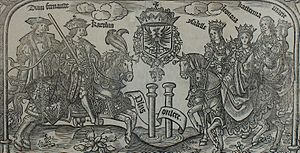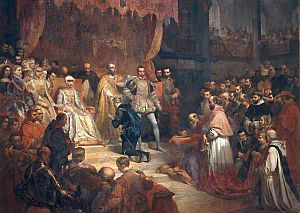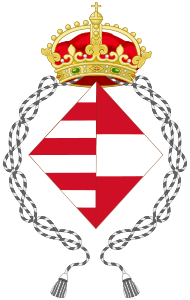Mary of Hungary (governor of the Netherlands) facts for kids
Quick facts for kids Mary of Austria |
|
|---|---|

Portrait by Hans Maler zu Schwaz c. 1520
|
|
| Queen consort of Hungary and Bohemia | |
| Tenure | 22 July 1515 – 29 August 1526 |
| Coronation | 11 December 1521 (Hungary) 1 June 1522 (Bohemia) |
| Governor of the Habsburg Netherlands | |
| In office 28 January 1531 – 25 October 1555 |
|
| Monarch | Charles V |
| Predecessor | Margaret of Austria |
| Successor | Emmanuel Philibert of Savoy |
| Born | 15 September 1505 Brussels, Netherlands |
| Died | 18 October 1558 (aged 53) Cigales, Spain |
| Burial | El Escorial |
| Spouse | |
| House | Habsburg |
| Father | Philip I of Castile |
| Mother | Joanna of Castile |
| Religion | Christianity (Catholicism) |
| Signature |  |
Mary of Austria (born 15 September 1505 – died 18 October 1558), also known as Mary of Hungary, was an important European ruler. She was the queen of Hungary and Bohemia as the wife of King Louis II. Later, she became the governor of the Habsburg Netherlands.
Mary was the daughter of Queen Joanna and King Philip I of Castile. She married King Louis II of Hungary and Bohemia in 1515. Their marriage was happy but short, and they had no children. After her husband died in the Battle of Mohács in 1526, Queen Mary became the regent of Hungary. She ruled for her brother, Ferdinand I, who was the new king.
In 1530, her aunt Margaret passed away. Mary's older brother, Emperor Charles V, asked her to become the governor of the Netherlands. She also became the guardian of her nieces, Dorothea and Christina of Denmark. As governor, Mary faced many challenges, including riots and a difficult relationship with her brother, the Emperor. She worked hard to keep peace between the Emperor and the King of France. Even though she never truly enjoyed governing and often asked to resign, Mary successfully brought the provinces together. She also helped them gain some independence from both France and the Holy Roman Empire. After she finally resigned, Mary moved to Castile, Spain, where she later died.
Contents
Mary's Early Life and Education
Mary was born in Brussels on 15 September 1505. She was the fifth child of King Philip I and Queen Joanna of Castile. Her birth was very difficult, and her mother took a month to recover. Mary was named after her grandmother, Mary of Burgundy. Her godfather was her grandfather, Holy Roman Emperor Maximilian I.
In 1506, Emperor Maximilian promised that Mary would marry the first son of King Vladislaus II of Hungary. At the same time, Mary's brother would marry Vladislaus' daughter Anne. Three months later, Vladislaus' wife had a son, Louis Jagiellon.
After Mary's father died in 1506, her mother's mental health became poor. Mary, her brother Charles, and her sisters Eleanor and Isabella were raised by their aunt, Archduchess Margaret. Mary, Isabella, and Eleanor were educated together at their aunt's court in Mechelen. They learned music from Henry Bredemers.
Becoming Queen of Hungary and Bohemia
Mary was called to her grandfather Maximilian's court in 1514. On 22 July 1515, Mary and Louis were married in St. Stephen's Cathedral, Vienna. Louis' sister Anne was also promised to one of Mary's brothers. Because Mary and Louis were young, they did not live together for a few years.
Anne eventually married Mary's brother Ferdinand. They were educated together in Vienna until 1516. That year, Mary's father-in-law died, making Louis and Mary the king and queen of Hungary and Bohemia. Mary moved to Innsbruck for her education until 1521. She and Anne learned about hunting and physical skills. They also received a Humanist education, which focused on solving problems. They learned dancing and music and met many thinkers who visited the imperial library.
This time helped Mary develop her skills. Like her grandfather Maximilian, Mary was very curious. She became interested in how to govern and in military matters. This passion would later help her as governor of the Netherlands.
Life with King Louis
Mary traveled to Hungary in June 1521. She was crowned queen of Hungary in Székesfehérvár on 11 December 1521. Her coronation was followed by big celebrations. The royal marriage was blessed in Buda on 13 January 1522. Mary was crowned queen of Bohemia on 1 June 1522.
Mary and Louis truly loved each other. At first, Queen Mary did not have much power in Hungary and Bohemia because she was young. Her court had many German and Dutch people who supported the House of Habsburg. By 1524, Mary gained significant power and influence. In 1525, she took control of a strong political group.
During her time as queen, Mary caught the attention of Martin Luther, who wrote four psalms for her in 1526. Mary was interested in Luther's ideas, but her brother Ferdinand strongly disagreed. Mary eventually turned away from Luther's teachings because of pressure from Ferdinand.
Louis and Mary enjoyed riding and hunting near the palace. They tried to get the Hungarian nobles to fight against the coming Ottoman invasion. Mary worked with her brother Ferdinand to organize Hungary's defense against the Ottoman Empire. She was stronger and more determined than Louis. However, she relied on non-Hungarian advisors, which made some Hungarians dislike her.
Louis had inherited a country where nobles fought among themselves and with the peasants. Hungary was divided when, in late 1525, it became clear that the Ottoman Sultan Suleiman I planned to invade.
Ottoman Invasion and Louis's Death
| "If she [Mary] could only be changed into a king, our affairs would be in better shape." |
| A letter from a Hungarian courtier to Desiderius Erasmus |
| "The most serene queen is about twenty-two years old, of diminutive stature, long and narrow face, rather comely, very spare, with a slight colour, black eyes, her under lip rather thick, lively, never quiet either at home or abroad." |
| A description of Mary by the Venetian ambassador at the Hungarian court |
On 29 August 1526, Suleiman and his army broke through Hungary's defenses. Louis and his government marched out with a small army of 20,000 men. The Battle of Mohács ended in less than two hours. The Hungarian army was almost completely destroyed. Louis tried to escape but fell from his horse and drowned. Mary mourned him for the rest of her life.
Hungary was then split into three parts. One part became part of the Ottoman Empire. Another part, Royal Hungary, was ruled by Mary's brother Ferdinand. The third part, Eastern Hungarian Kingdom, was ruled by John Zápolya. Ferdinand was elected King of Bohemia. Mary promised never to remarry. She always wore a heart-shaped medallion that her husband wore in the battle.
Mary as Regent in Hungary
The day after her husband died, Mary told Ferdinand about the defeat. She asked him to come to Hungary and send troops to help her. Ferdinand was busy in Bohemia, where he had already been elected king. Instead, he named Mary his regent in Hungary.
Mary spent the next year working to make sure Ferdinand was elected King of Hungary. On 14 February 1527, she asked to resign as regent. Ferdinand said no. Mary had to stay in the role until the summer of 1527, when Ferdinand finally came to Hungary. Mary was relieved when he took the crown.
Mary soon faced money problems, illnesses, and loneliness. In 1528, her aunt Margaret suggested she marry King James V of Scotland. Mary refused because she loved her husband and did not want to marry again. In 1530, Charles again suggested she remarry. He proposed Frederick of Bavaria. Mary refused him too.
Ferdinand offered Mary the regent position again in 1528, but she said no. She felt that "such affairs need a person wiser and older." Ferdinand kept trying to involve Mary in his plans. Their aunt Margaret died on 1 December 1530. This left the position of Governor of the Seventeen Provinces in the Netherlands empty. Ferdinand told Mary about their aunt's death, hinting that her life might "take a different course."
Governor of the Netherlands
On 3 January 1531, Mary's older brother, Holy Roman Emperor Charles V, asked her to become the regent of the Netherlands. Charles ruled a huge empire and needed trusted family members to govern his distant lands. Mary reluctantly agreed because Charles insisted. On 6 October 1537, the Emperor wrote to her:
I am only one and I can't be everywhere; and I must be where I ought to be and where I can, and often enough only where I can be and not where I would like to be; for one can't do more than one can do.
Mary was a very good regent. Charles made her stay in the job and gave her more power than their aunt had. However, Mary was very unhappy as governor and never enjoyed her role. In May 1531, after only four months, Mary told her brother Ferdinand that the experience was like having a rope around her neck. While Margaret was seen as kind and charming, Mary was firm and bossy. Margaret achieved her goals with a smile, but Mary used sharp comments. Unlike her aunt, Mary found it hard to forgive. She felt that her lack of "power as a woman" was her main problem.
Caring for Her Nieces
Becoming regent in the Netherlands also meant becoming the guardian of her nieces, Dorothea and Christina of Denmark. They were the daughters of her older sister, Queen Isabella of Denmark, who had died in 1526. After Isabella's death, the princesses had been cared for by Archduchess Margaret. Charles now relied on Mary to arrange marriages for them, especially for Dorothea, whom he wanted to place on the Danish throne.
In 1532, Francesco II Sforza, Duke of Milan, suggested marrying Christina, who was only 11 years old. Charles agreed to the marriage and wanted it to happen right away. Mary strongly opposed this. She told Charles that Christina was too young for marriage. Charles ignored her, but Mary still managed to delay the wedding. She first told the Milanese messenger that her niece was sick. Then she took Christina to another part of the Netherlands for "important matters." Christina finally married on 28 September 1532, but Mary managed to postpone her departure until 11 March 1533.
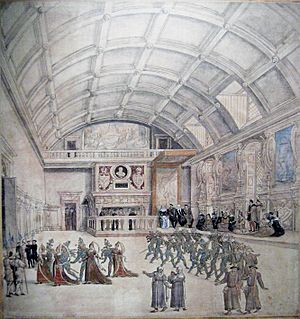
Right after Christina left, Mary became ill. She asked to resign as governor, but Charles did not allow it. A year later, Dorothea also married. A few months after Dorothea left, Christina, who was now a widow, returned to her aunt's court. King Henry VIII of England immediately proposed marriage to Christina. Charles urged Mary to arrange the marriage. Mary was not in favor of this marriage and delayed it. Henry VIII was excommunicated in 1539, so Charles had to end the talks.
Mary's Relationship with Charles
The Emperor trusted Mary's loyalty to the Catholic Church. He knew that the Queen could not be easily pushed around, especially on personal matters. However, in October 1531, Charles warned her. He said that if any family member followed Luther, he would consider them his greatest enemy. Mary was therefore forced to stop Protestantism in the Netherlands, even if she was tolerant of other religions. But she always tried to enforce her brother's religious laws as little as possible. She was accused of protecting Protestants many times.
Her strong will sometimes caused arguments with Charles. In most matters of power, Mary had to let Charles decide. He often criticized her choices, which affected their otherwise loving relationship.
Dealing with Riots and Rebellions
| "Whoever is in charge of this country should be very sociable with everyone in order to gain the goodwill both of the nobility and the commonality; for this country does not render the obedience which is due to a monarchy, nor is there an oligarchical order nor even that of a republic. And thus a woman, especially if she is a widow, cannot do what should be done." |
| Mary to Charles on the occasion of his abdication as sovereign of the Netherlands. Brussels, 1555. |
Mary worried about losing her authority and had financial problems in February 1534. She complained that the budget could not be balanced, even during peacetime. Charles assured her that she was doing her best.
In August 1537, the Queen complained to Charles that the Low Countries were no longer governable. She said he should come himself. In fact, Mary handled the crisis very well and stayed calm in public. In October, she traveled to northern France to meet her brother-in-law, King Francis I of France. On October 23, they signed a treaty. Francis promised Mary he would not help those who rebelled against her. The Queen promised to pay French nobles who lost land in the Low Countries during the Italian Wars.
Military Policies and Defense
In 1534, Mary suggested a plan for all the provinces to unite for defense. She presented the idea at the States General in Mechelen in July. She said her brother wanted the provinces to help each other. The plan had to be given up. Mary's letters to Charles started to sound like their aunt Margaret's dramatic outbursts.
Mary wanted peace in the Netherlands. Charles did not pay attention to her problems as governor and often ignored her warnings. One time, this led to Charles losing the city of Metz to France. Mary had to fight a war against France in 1537. She also had to deal with the Revolt of Ghent between 1538 and 1540. Mary's job as Governor of the Netherlands was renewed on 14 October 1540, after the revolt in Ghent was stopped.
Protecting the Herring Fleet
In the last ten years of her rule, Scottish privateers (pirates) became a big problem in the North Sea. In 1551, merchants from Antwerp said that Scottish pirates had taken ships and goods worth about 1,600,000 Holland pounds over eight to ten years. In 1547, Mary called together leaders from the three fishing provinces. They debated the problem. Many wanted "safe-conducts," which they thought were cheaper than building warships. But the Queen refused to negotiate with a weak Scottish government.
Even though people did not want to spend money on warships, Mary acted firmly. She ordered that no fishing boats could sail until the provinces made a good plan for naval defense. Because of her pressure, the provinces agreed to create a common Netherlands war fleet. Mary's chief naval strategist, Cornelis de Scepper, created a plan. A large navy would patrol the Maas Estuary, and fast yachts would communicate with the fishing fleet. Holland agreed to provide eight warships for a fleet of twenty-five ships. This fleet would protect all trade in the North Sea. Historians say that Mary of Hungary and her officials deserve much credit for this new defense strategy.
Mary, Admiral Maximilian of Burgundy, and Councillor Cornelis de Schepper worked together to make the Low Countries' naval policy more professional between 1550 and 1555. The central government, led by Mary, tried to make the provinces accept the Admiralty's authority. Mary preferred de Schepper over Maximilian, but the two men trusted each other. The three formed a great team. De Schepper was the mastermind, writing all the plans for naval policies. From 1550 to 1555, he was as important as the Admiral in preparing warships and organizing convoys. Their efforts led to the creation of a permanent navy. Mary showed herself to be a practical and strong leader in this process.
Mary's Resignation
In 1555, Mary had to help her brothers. Charles decided to step down as emperor and give the Netherlands to his son Philip. Ferdinand disagreed. When Mary heard of Charles's decision, she told him she would also resign. Both Charles and Philip urged her to stay, but she refused. She explained the difficulties she faced because she was a woman. She also mentioned disagreements with Charles and her age. She did not want to get used to her nephew's ways after years of dealing with Charles's demands. The real reason for Mary's resignation was her many arguments with her nephew. She asked Charles if she could leave the Netherlands after resigning. She feared she would be pulled back into politics if she stayed.
Charles finally allowed his sister to resign. She officially announced her decision on 24 September 1555. On 25 October, her power was given to Philip. Philip did not personally like his aunt, but he still tried to convince her to return to the job. After another argument with Philip, Mary went to Turnhout. She stayed in the Netherlands for one more year.
Life in Castile, Spain
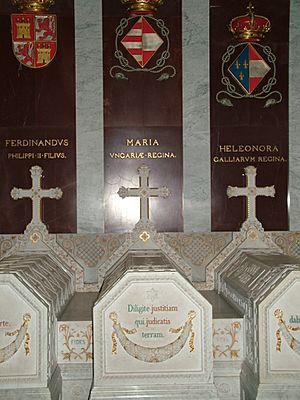
Mary wanted to retire to Castile and live with her recently widowed sister Eleanor. Charles had also retired there. Mary was afraid to move to Castile. Her mother Joanna (who died in April 1555) had been queen there, but Mary had never lived in Castile. She worried that if Eleanor died, she would be alone in a country whose customs she did not know. In the end, she decided to move to Castile. She kept open the option of moving back to the Netherlands if she could not adjust. Charles, Eleanor, and Mary sailed from Ghent on 15 September 1556.
Mary repeatedly told her brother that she did not want to be involved in state affairs. However, she offered to advise her niece Joan, who was serving as regent for Philip. Joan did not want to share power and declined her aunt's offer.
Mary did not enjoy her retirement for long. Eleanor died in her arms in February 1558. Mary was heartbroken. She traveled to Charles to ask for advice about her future. Charles told her he wanted her to be regent in the Netherlands again. He promised her a home and a large income, but Mary declined. Her nephew Philip then urged her advisor to convince her to return. When Charles became ill in August, Mary accepted the offer. She decided she would become governor again.
In September, Mary was ready to leave for the Netherlands and resume her post. Then she learned of Charles's death. Mary had suffered from heart disease most of her life. Distressed by the death of another sibling, she had two heart attacks in October. Both were so severe that her doctors thought she had died. When Joan visited her, Mary was still determined to keep her promise to Charles. She wanted to be regent in the Netherlands, but she was weak and had a fever. She died only a few weeks later, in Cigales on 18 October 1558.
In her last will, Mary left all her possessions to Charles. Since Charles had died, Philip inherited his aunt's property. Shortly before her death, she asked Philip and Joan to carry out her will. She requested that her heart-shaped gold medallion, once worn by her husband, be melted down. The gold was to be given to the poor.
Queen Mary was first buried in the Monastery of Saint Benedict in Valladolid. Fifteen years after her death, Philip ordered that her remains be moved to El Escorial.
Mary's Support for the Arts
Mary loved collecting art. She owned several important masterpieces of Early Netherlandish painting. These included the Deposition of Christ by Rogier van der Weyden. It is now in the Museo de Prado. She also owned the Arnolfini Portrait by Jan van Eyck, which is now in the National Gallery, London. Most of her collection went to the Spanish Royal Collection after she died.
Queen Mary of Hungary was a great supporter of music. She supported both religious and non-religious music at her court in the Netherlands. Her main music director was Benedictus Appenzeller. Several beautiful music manuscripts she ordered are kept in Spain at the monastery of Montserrat.
Mary's Appearance and Personality
According to historians, Mary was not considered physically attractive. She had the Habsburg lip and did not have very feminine looks. Her portraits, letters, and comments from people at the time do not describe her as having the easy charm of her grandmother, Duchess Mary of Burgundy, or her aunt Margaret. However, she was a determined and skilled politician. She also loved literature, music, and hunting. The historian Pierre de Bourdeille found her beautiful and charming, even with a slight tendency towards being masculine. People close to her also found her charming. What made her seem masculine was her strong, bossy manner, her very public life, and her "masculine" activities. These often led to criticism because they were seen as going beyond "acceptable female behavior."
Arms
- Heraldry of Mary of Hungary
See also
 In Spanish: María de Hungría (1505-1558) para niños
In Spanish: María de Hungría (1505-1558) para niños


